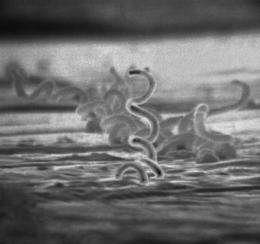October 27, 2010 report
Columbus cleared of bringing syphilis to Europe

(PhysOrg.com) -- A long-held theory has it that Christopher Columbus and his crew returned to Europe in 1493 from their trip to the Americas bringing syphilis with them, and research reported in PhysOrg in 2008 also suggested Columbus was to blame. Now an excavation of skeletons in a London cemetery has unearthed seven skeletons that suggest the disease was present in Europe nearly two centuries earlier.
The seven skeletons unearthed at St Mary Spital in East London have rough patches on their limbs and skulls suggestive of syphilis. Syphilis is a sexually transmitted disease caused by the bacterium Treponema pallidum and before antibiotics were available it was often fatal, causing damage to the brain, heart, and eyes. It also produced tell-tale indentations in the skull and other bones, and could be passed on to the children of sufferers.
One of the skeletons found at St Mary Spital was that of a child about 10 years old. Osteologist Brian Connell of the Museum of London, who studied the skeletons, said the child had teeth growing at an angle of 45 degrees through the jaw because of the disease, and the skull “looks like a lunar landscape. He said the finding caused “a bit of a stir” because the symptoms of syphilis were so obvious.
Connell said he believes the bodies were buried well before Columbus set sail, since radiocarbon dating of bone samples dates two of them at 1200 to 1250 and the five others at 1250 to 1400. Radiocarbon dating is an estimated 95 percent accurate, and other objects such as coins were found in the vicinity that corroborate the date estimates.
Connell said a pandemic of syphilis swept through Europe in 1495 and everyone at the time was seeking a scapegoat: the English called it the French pox, the Tahitians called it the British disease, and the Dutch called it the Spanish pox, for example. Since the newly-discovered skeletons pre-date Columbus, he and his crew could not be to blame for the emergence of the disease in Europe, and Connell said it was probably just coincidence the first well-documented outbreak occurred after Columbus had returned.
© 2010 PhysOrg.com
















